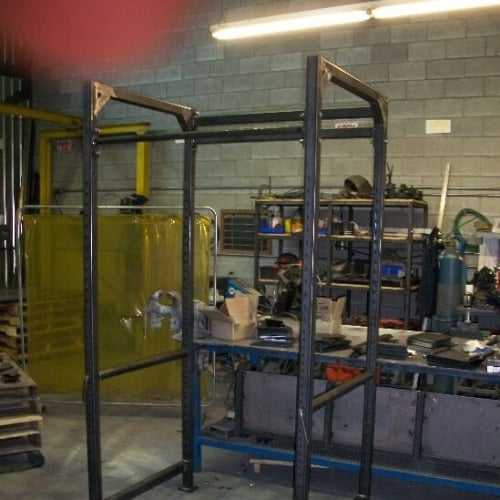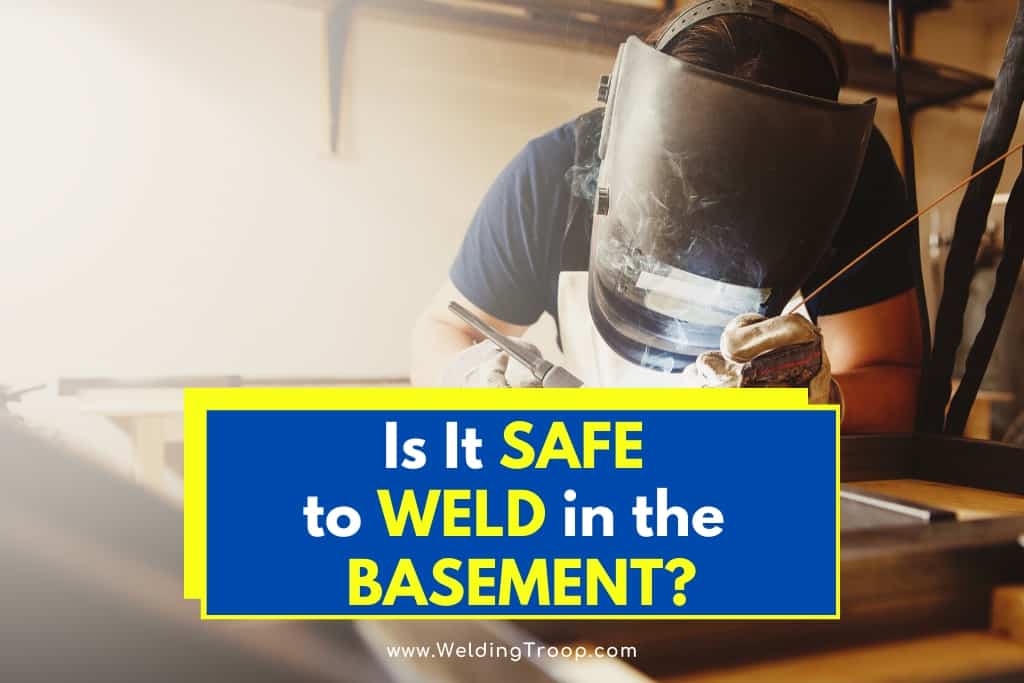If you´ve ever been wondering if is it safe to weld in the basement, then please keep reading. Welding can be an incredibly helpful skill to know, but it can be difficult to find a location that allows you to practice your welding skills. Some people who enjoy the practice or have strong welding skills choose to work in welding industries, but others prefer to use their welding abilities on the side for personal projects.
Is it safe to weld in the basement? In general, it is not safe to do any welding in a basement because there are fire risks, and the area may lack the necessary ventilation. If the welding area is not ventilated enough, you can be exposed to harmful fumes.
There are many different types of welding, and although there are a few types of welding you can do indoors, the proper indoor spaces need to be much more open than a basement typically is. In fact, for nearly all types of welding, even the basic ventilation systems in warehouses are not enough to protect workers from harmful fuels, and systems that are specifically designed to eliminate welding fumes must be installed.
Table of Contents
What is Welding?
You have probably heard of welding at least once in your life, but you may not understand what the process is, or you may be unaware that there are many different types of welding.
The process of welding is used to join metals together through heat. The metals are heated up to their melting points and are then joined together. Since different metals have different melting points, welding is a complex process to understand and carry out.
Welding In Basement
It is not recommended to weld in a basement due to safety concerns. Welding can be dangerous due to fire risks and lack of proper ventilation. Basements may not have adequate ventilation, which can cause suffocation from argon gas used in TIG welding or rising fumes.
Sparks from welding can also pose a fire hazard in closed spaces beneath homes. Proper safety measures, protective gear, and equipment checks are crucial to prevent accidents while welding. It is best to find a safer location for welding tasks, such as an outdoor area or a properly ventilated workshop.
The Occupational Safety and Health Administration (OSHA) has detailed regulations on ventilation requirements for welding, cutting, and heating to prevent exposure to toxic metals.
Therefore, it is important to prioritize safety when welding and follow the recommended guidelines and regulations.
Is There a Way to Weld at Home?
Since you can use the process of welding for nearly countless metals and projects, there are many different types of welding. The various kinds allow you to achieve specific results. Different welding processes are also used in different environments.
It is important to note that while there are types of welding that can be carried out in confined spaces that are properly ventilated, basements do not have the required ventilation or absence of fire risks that are needed to safely weld.
That being said, you can still find a safe way to practice your welding skills at home. It is a bad idea to weld inside your home because there are so many risks of fire or reactions between gases. But you can set up a nice area to weld safely in a garage or similar structure with proper ventilation.

If you decide to set up an area at your house to weld from, a garage that you can ventilate is your best option. Before you start heating up any metals, take the time to make sure there are no fire risks in the garage. Sparks from the welding can reach several feet away, and you must make sure that they will not hit anything flammable.
Welding Fume Extractor
Based on the information found in the search results, I strongly advise against welding in a basement, regardless of whether you use TIG or stick welding. Welding produces harmful fumes and gases that can be dangerous to inhale, especially in poorly ventilated spaces.
While there are cheaper welding fume extractors available, it is not recommended to rely on homemade exhaust fans or to use ductwork without a proper filtration system.
It is best to find a safer location for welding tasks and follow safety measures to prevent accidents, such as wearing protective gear and using proper ventilation systems
What Safety Measures Are Needed for Welding?
Even if your welding area is properly set up for safety, you still need to have the proper materials to protect yourself while welding.
Removal of Fire Hazards
When you are welding, you will be working with intense heat that will likely involve sparks. All potential fire hazards must be removed before you start to weld. This is especially important if you are welding in an environment that is partially closed off.
Even in an open area or workspace, you must act with caution and remove any potential fire hazards. It is not a bad idea to have a working fire extinguisher nearby in case anything goes awry.
Once you have finished welding in a work area, it is best to stick around for another 30 minutes afterword to make sure that no fires pop up. You should also always be aware of fire exits and fire alarms closest to you in the case that a fire does start.
Proper Welding Apparel
Many people can probably recognize a welder by the strange facial shield that covers a welder’s face and neck. Welding can be extremely dangerous, and the proper protective gear is an absolute must to prevent accidents.
Basic welding apparel that is safe includes:
- Full-length pants (These should not have cuffs, which can be a tripping hazard and may be a fire hazard.)
- Flame-resistant jacket (This should be long sleeves.)
- Leather shoes/boots tucked under pant legs
- Leather gloves that extend past the wrist
- Safety goggles
- Welding helmet
- Bandana or skull cap (This should go under the welding helmet to protect your head from any sparks.)
Depending on the type of welding you do, you may have to have additional specialty equipment to fully protect yourself from harm. Always wear protective gear while welding, even if you are just doing one little part.
Check Your Equipment
Before you start to weld, you should always check your equipment to make sure everything is working properly. If your equipment is not set up correctly, you are at risk of fire, electrical shock, or other types of injury.
Always check the cables on your equipment to make sure they are connecting tightly without any fraying. For some types of welding, you may have to change the electrode polarity of your equipment, and you should make sure it is on the correct setting while you check the rest of your equipment.
Make sure that your gas flow is working properly and at the rate that you need. Over time, gas hoses can get leaks that may release harmful fumes, or pose other risks. To test for a leak in a gas hose put a soap and water solution in the machinery and see if there are bubbles produced. Always get rid of gas hoses that have a leak and replace them with new ones.
What Types of Welding Are There?
Different metals and projects require different welding techniques to achieve the desired result. Some projects may require a specific type of welding, while others could be completed with multiple types. here is an article we wrote about 9 different types of welding processes & their advantages.
Submerged Arc Welding
This welding process uses an arc, which is an electric current between the welding device and the materials, between a weld pool and bare metal electrodes. Since the weld is shielded by granular flux, it becomes submerged, hence the name.
Tungsten Inert Gas (TIG) Welding
TIG welding is also an arc welding process that uses an arc between the work piece and a tungsten electrode that is non-consumable. TIG welding works for non-ferrous metals and uses shielding gas to eliminate flux.
It is important to note that TIG equipment should be carefully inspected for argon leaks as these can cause suffocation if there is too much exposure. Ventilation is key.
Metal Inert Gas (MIG) Welding
This process is also clean like TIG welding because it uses a shielding gas. It is also known as gas metal arc welding since it uses a continuous filler metal electrode with the weld pool. MIG welding works especially well for aluminum.
MIG welding is not usually done outdoors, but the process still requires careful attention to safety. For a more in-depth explanation of MIG welding to help you find out if you can use MIG welding at home, see this link
Stick Welding
This process is also called shielded metal arc welding. It is popular for construction work and is inexpensive. Since stick welding uses straight electrodes that have coatings made of chemicals that can be hazardous, proper ventilation is especially important for this process.
Final Thoughts
Ultimately, it is not safe to weld in your basement. It is much better to opt for an area that has access to more ventilation, like a garage. It is also important to keep in mind what metals and types of welding you are using so that you can implement the right safety measures.

